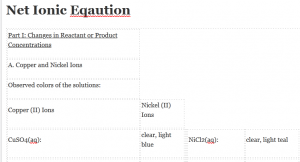Net Ionic Eqaution

| Part I: Changes in Reactant or Product Concentrations | |||||
| A. Copper and Nickel Ions | |||||
| Observed colors of the solutions: | |||||
| Copper (II) Ions | Nickel (II) Ions | ||||
| CuSO4(aq): | clear, light blue | NiCl2(aq): | clear, light teal | ||
| [Cu(NH3)4]2+(aq): | clear, dark blue | [Ni(NH3)6]2+(aq): | cloudy (precip), dark blue/green | ||
| After HCl addition: | produced heat and formed water vapor | After HCl addition: | produced heat, water vapor, cleared the color, and removed the precipitate
|
||
| a.) Explain your observations upon addition of NH3(aq) to the CuSO4 and NiCl2 solutions. Include balanced net ionic equations (2) and explain what happens in the reactions in terms of LeChâtelier’s principle as more NH3(aq) is added.
b.) Explain your observations upon addition of HCl(aq) on the solutions. Include the balanced net ionic equation for the reaction that occurs. Explain which way the equilibria in (a) shift and why in terms of LeChatlier’s principle as HCl is added. c.) What initially forms as pale blue and pale green precipitates when NH3(aq) is added to [Cu(H2O)4]2+ and [Ni(H2O)6]2+ solutions, respectively? Why do these precipitates form?
|
|||||
| B. Cobalt Ions | |||||
| Color of original CoCl2 solution: | Clear, see through red, no precipitate | ||||
| Color after adding HCl(aq): | Dark purple, clear, formed water vapor | ||||
| Color after adding H2O: | Cleared changes, returned to red, see through. | ||||
| a.) Explain your observation upon addition of 12 M HCl(aq) to the original CoCl2 solution. Include a balanced net ionic equation and explain which way the equilibrium shifts as more HCl(aq) is added and why in terms of LeChâtelier’s principle.
b.) Account for your observation when adding water to the [CoCl4]2- complex solution. Explain which way the equilibrium in (a) shifts as water is added and why in terms of LeChâtelier’s principle.
|
| Part II: Equilibria Involving Sparingly Soluble Salts | |
| Appearance of Na2CO3 Solution: | Clear, no color |
| Appearance of AgNO3 Solution: | Clear no color |
| Observed Changes on Mixing: | bright yellow “lemon-aid” color, with a cloudy precip. |
a.) Write the balanced net ionic equation for the equilibrium that is established upon mixing. Why does this equilibrium occur?
| Observations upon addition of HNO3: | 1 drop cleared the solution, no color, no precipitate |
| a.) Account for your observations when adding HNO3(aq). Include the balanced net ionic equation and explain which way the equilibrium in (a) shifts and why in terms of Le Châtelier’s principle.
b.) Which ions remain in the test tube after addition of HNO3(aq)?
|
|
| Observations upon addition of HCl: | Formed a solid and chunky precipitate, though not cloudy |
| a.) Write the balanced net ionic equation for the equilibrium that is established when HCl(aq) is added to the test tube. Why does this equilibrium occur?
|
|
| Observations upon addition of NH3: | Solution clears out, removing the cloudy precipitate |
| a.) Explain your observation when excess NH3(aq) is added to the test tube. Include a balanced net ionic equation and explain which way the equilibrium in (d) shifts as NH3 (aq) is added and why in terms of LeChâtelier’s principle.
|
|
| Observations upon addition of HNO3: | Remains clear, and colorless, produces a water vapor and heat. |
| a.) Account for your observations when adding HNO3(aq). Include a balanced net ionic equation for the reaction that occurs and explain which way the equilibrium in (e) shifts as HNO3(aq) is added and why in terms of Le Châtelier’s principle.
b.) Which ions and/or solids are present in the test tube after the addition of HNO3(aq)?
|
|
| Observations upon 2nd addition of NH3: | No change was observed |
| a.) Explain your observation when excess NH3(aq) is added to the test tube. Include a balanced net ionic equation and explain which way the equilibrium in (d) shifts as NH3 (aq) is added and why in terms of LeChâtelier’s principle.
|
|
| Observations upon addition of KI: | Color changes to bright yellow “lemonade” color, with a cloudy precipitate |
| a.) Account for your observations when adding KI(aq). Include a balanced net ionic equation for the reaction that occurs and explain which way the equilibrium in (h) shifts as KI(aq) is added and why in terms of Le Châtelier’s principle.
|
| Part III: Effect of Temperature on Equilibria | |
| Temperature of cool CoCl2: | 24° C |
| Color of cool CoCl2 (before heating): | Clear and medium red |
| Temperature of hot [CoCl4]2-: | 75° C |
| Color of hot [CoCl4]2- (after heating): | Deep dark red, though still clear |
| a.) Is the reaction exothermic or endothermic? Explain your answer.
|
Discussion Questions
1. Based on your observations on Part I, what could be expected to happen if the solution of [Cu(NH3)4]2+ were diluted with water. Use a balanced net ionic equation to explain.
2. In the equilibrium, X3+(aq){yellow}+Y-(aq){colorless}↔[XY4]-(aq){red}, what would be indicated if heating the solution caused an intense dark red color and the solution turned yellow in an ice bath?
3. Consider the following equilibria occurring simultaneously:
Fe3+(aq){pale yellow}+SCN-(aq){colorless}↔[FeNCS]2+(aq){dark red}
Ag+(aq)+SCN-(aq)↔AgSCN(s)
2Fe3+(aq)+Sn2+(aq)↔ 2Fe2+(aq)+Sn4+(aq)
Would the color of the solution get darker or lighter if silver nitrate were added to the test tube? Explain why in terms of Le Châtelier’s Principle.
4. Would the color get darker or lighter if tin (II) chloride were added to the test tube? Explain why in terms of Le Châtelier’s Principle